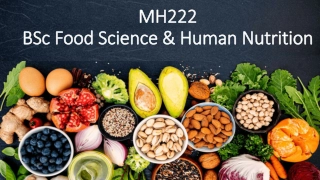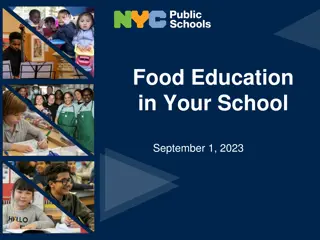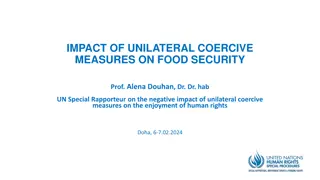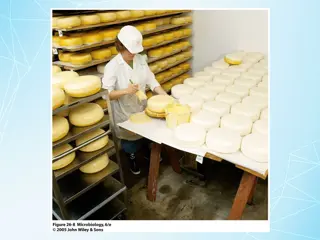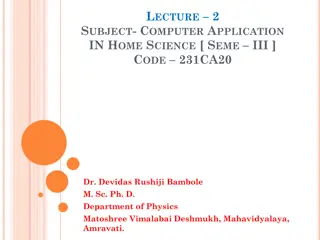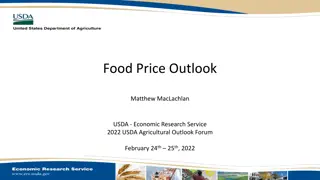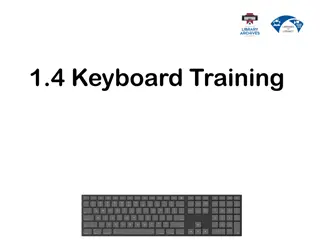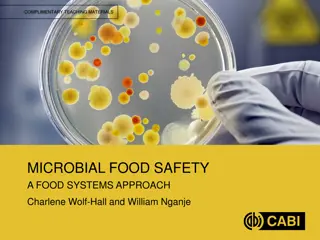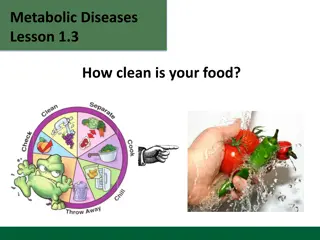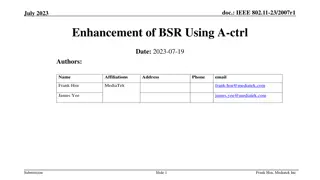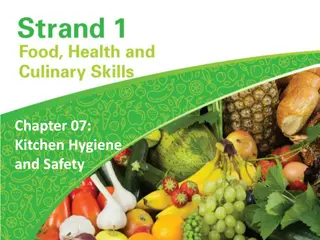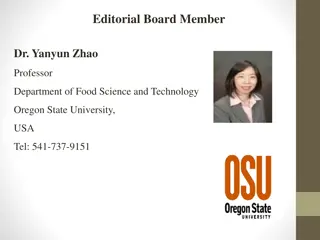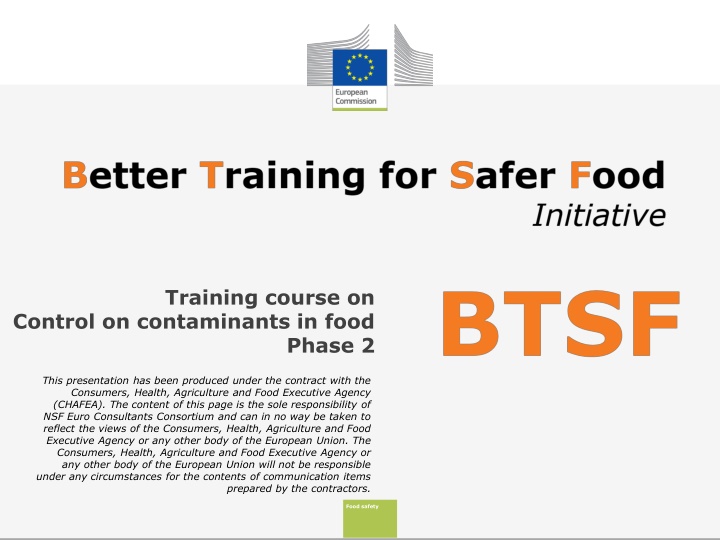
Control Measures for Contaminants in Food: EU Regulations Overview
"Learn about EU risk management measures for agricultural, environmental, and industrial contaminants in food. Explore tools, regulations, and dietary advice for ensuring food safety and reducing exposure to harmful substances."
Download Presentation

Please find below an Image/Link to download the presentation.
The content on the website is provided AS IS for your information and personal use only. It may not be sold, licensed, or shared on other websites without obtaining consent from the author. If you encounter any issues during the download, it is possible that the publisher has removed the file from their server.
You are allowed to download the files provided on this website for personal or commercial use, subject to the condition that they are used lawfully. All files are the property of their respective owners.
The content on the website is provided AS IS for your information and personal use only. It may not be sold, licensed, or shared on other websites without obtaining consent from the author.
E N D
Presentation Transcript
Training course on Control on contaminants in food Phase 2 This presentation has been produced under the contract with the Consumers, Health, Agriculture and Food Executive Agency (CHAFEA). The content of this page is the sole responsibility of NSF Euro Consultants Consortium and can in no way be taken to reflect the views of the Consumers, Health, Agriculture and Food Executive Agency or any other body of the European Union. The Consumers, Health, Agriculture and Food Executive Agency or any other body of the European Union will not be responsible under any circumstances for the contents of communication items prepared by the contractors. Food safety
Control measures for contaminants in feed and food: part 1, food contaminants Overview of EU risk management measures covering the agricultural, environmental and industrial contaminants in food Ms. Klara Jirzik / Ms. Annette Rexroth 1 Food safety
Reminder: Overview on risk management tools for contaminants in food General food safety provisions established in Reg. 178/2002 (GFL): Precautionary principle (Art. 7 of GFL) Public information (Art. 10 of GFL) Withdrawal/recall of unsafe food from the market/consumer (Art. 14 of GFL) RASFF and crisis management (Art. 50 - 57 of GFL) Safeguard measures as regards the import of certain food from certain 3rd countries (Art. 53 of GFL) 2 Food safety
Reminder: Overview on risk management tools for contaminants in food Management instruments specifically applied for food contaminants: Legally binding Maximum Levels (Reg. (EC) No 1881/2006) Prevention/mitigation strategies (based on Art. 2 reg. (EC) 315/93: ALARA-principle). The preventive approach is often used in combination with indicative, benchmark or action values (serve as early warning tool or performance indicators) Monitoring and data collection surveys (risk assessment/risk management cycle) 3 Dietary consumption advice Food safety
Commission Regulation (EC) No 1881/2006 on Maximum Levels (MLs) for contaminants in food MLs are established for: agricultural contaminants: nitrate in certain leavy vegetables mycotoxins in cereal(products), oilseeds, nuts, dried fruits and spices, baby food etc. ergot sclerotia in unprocessed cereals inherent plant toxins (erucic acid in oils, tropane alkaloids in (cereal-based)baby food, hydrocyanic acid in apricot kernels) environmental contaminants: metals and other toxic elements, dioxins and PCBs in various foodstuffs process contaminants: 3-Monochloropropane-1,2-diol 3-MCPD (esters) and glycidylesters in vegetables oils and baby foods, polycylclic aromatic hydrocarbons (PAH) in oils, fats, smoked meat/fish, baby foods etc. melamine and its structural analogues (baby food) MLs = Efficient tool to reduce exposure to high levels of contaminants 4 Food safety
MLs vs Preventive Approach However, setting MLs may not always be feasible in practice or may not provide a sufficient health protection level: extensive sampling and compliance testing of every lot of final product not possible Rejection and destruction of whole lots in case of exceedance of ML ML-based measures focus more on control of final products rather than tackling contamination at source Derivation of ML not possible/appropriate in case of insufficient knowledge on risk profile of a contaminant and/or its presence in the food Need for Preventive/mitigation Measures! 5 Food safety
Principles and advantages of preventive approach Based on minimization strategies such as good agricultural/production practices, HACCP/self control system of FBOs, Code of Practices (CoP) More effective in preventing, controlling food and reducing contamination at source/all along the feed/food chain (key objective: ALARA) Good starting point for risk management strategy in case of knowledge gaps regarding the toxicology, presence and intake levels of a contaminant Elaboration of prerequisites for further risk management development (e.g. MLs) Flexible approach which can easily be adapted or improved according to technological progress/knowledge/availability of occurrence data MLs often used in combination with preventive approach to achieve a continuous reduction of contamination 6 Food safety
MLs vs. indicative, benchmark or action values MLs Indicative, action levels No legally-binding limits, no safety threshholds: their exceedance does not necessarily require the withdrawal of the food from the market serve as performance indicators to verify the effectiveness of the mitigation processes their exceedance indicates possible weaknesses in the mitigation process and the need for an investigation/action to identify the source of contamination and/or reduce contamination below these levels contrary to MLs, indicative or action levels are set at a much lower/ambitious level (e.g. P85) in order to stimulate mitigation efforts as much as possible Legally-binding limits: Foods not complying with the MLs: shall not be placed on the market shall not be used as food ingredients shall not be mixed with foods complying with these MLs main criteria for deriving MLs: occurrence data (usually P95 taken as basis) toxicological aspects availability of mitigation measures etc. 7 Food safety
Objectives of monitoring to obtain a reliable data basis on the presence of undesirable substances (e.g. contaminants) in food. Such a data basis is needed for exposure assessment and risk assessment (national/EFSA) to derive/improve targeted measures to minimise and manage risks (e.g. Max. levels for contaminants) to evaluate the progress/efficiency of mitigation and risk management measures To deduce trends over time To identify potential risks to consumers health Legal framework: Comm recommendations for monitoring Art. 9 of Reg. 1881/2006: monitoring of nitrate and ergot alkaloids in cereals and cereal products Art. 9 of Reg. 1881/2006: submission of monitoring data to EFSA EFSA call for continuos contaminants data collection 8 Food safety
Management of process contaminants: Acrylamide AA formed in foods with high content of reducing sugars (glucose, fructose) and asparagine (amino acid heated) above 120 C (MAILLARD REACTION) Minimisation based on Codex Code of Practice for the reduction of Acrylamide in Foods (CAC/RCP 67, 2009) Food Drink Europe (FDE) Toolbox Tools grouped according to relevant products (e.g. Potato based products, cereal based products, baby food, coffee) Guidance (brochures) for SME and hospitality sector for minimizing the presence of acrylamide Such mitigation tools are the basis of the new COMMISSION REGULATION (EU) 2017/2158 establishing mitigation measures and benchmark levels for the reduction of the presence of acrylamide in food 9 Food safety
Risk management approach for AA: Prevention/mitigation strategies Application of mitigation measures for AA-reduction obligatory for ALL FBOs all along the food production chain (detailed catalogue of measures given in Annexes I and II of Regulation 2017/2158) FBOs are obliged to verify the effectiveness of these mitigation measures through sampling and analysis Evaluation of the outcome/success of mitigation approach is based on benchmark levels (= performance indicators for FBOs and Cas, see Annex IV of Reg. 2017/2158) In case of their exceedance: FBO shall review and adjust mitigation processes/controls to achieve levels of AA below the benchmark (ALARA) mitigation measures adapted to the nature/size of FBO (principle of proportionality) Sampling and analysis requirements to be applied by FBO are established in ANNEX III of Reg. Future review and possible lowering of the benchmark levels on the basis of AA- occurrence data provided to EFSA by official CAs as well as FBOs 10 Food safety
Principles of data submission to EFSA Continuous Data collection for all types of contaminants and other undesirable substances (deadline: 1st Oct. each year): EFSA open call for competent authorities and stakeholders Submission of data by standardised electronic formats (SSD2, Foodex2-food categorization): allows a highly precise description of the samples and analytical data Data are used by EFSA for elaborating scientific opinions on exposure/ health risks in the food chain and are used for unionwide risk-management decisions For some contaminants (e.g. acrylamide) more detailed and specific information is mandatory acrylamide product categories/sub-categories required, as outlined in the following example: 11 Food safety
Minimization of environmental contaminants, persistent organic pollutants: dioxins and PCB Non-intentional by- products of a series of chemical and combustion processes Chemical products produced intentionally Dioxins PCBs (during 30 -70 ) Dioxins: group of 75 polychlorinated dibenzo-p-dioxin (PCDD) congeners and 135 and polychlorinated dibenzofuran (PCDF) congeners Polychlorinated biphenyls (PCBs) : 12 congeners with tox. properties similar to dioxins (dioxin-like (dl)-PCBs). Other have a different tox. profile (non- dioxin-like PCBs (ndl)-PCBs) A lot has been done to minimize anthropogenic contamination However, due their persistence and remobilization these contaminants can still enter the food chain Exposure of humans mainly by food of animal origin due to bioaccumulation 12 Food safety
Minimisation of dioxins and dl-PCB MLs in food: ML- approach Reg. EC No 1881/2006, section 5: maximum levels for dioxins, the sum of dl-PCBs and dioxins, as well as ndl- PCBs in foods of animal origin: e.g. fish, meat, eggs, milk, animal fats Vegetable oils, foods destined for infants and young children MLs expressed in terms of a quantifiable unit, namely the 2,3,7,8- tetrachlorodibenzodioxin (TCDD) toxic equivalent (TEQ) Updated risk assessment adopted by EFSA in June 2018: Risk for animal and human health related to the presence of dioxins and dl-PCBs in feed and food: new TWI for dioxins and dl-PCBS of 2 pg/kg BW (7 times lower than previous TWI): Exposure for all ages exceeds new TWI Possible lowering of some MLs in the future? 13 Food safety
Minimisation of dioxins and dl-PCB: Preventive approach COMM RECOMMENDATION 2013/711/EU on the reduction of dioxins, furans and PCBs in feed and food proactive approach based on action levels (early warning tool) in cases of non-compliance with MLs set in Reg. 1881/2006 and/or exceedance of action levels laid down in recomm. 2013/711/EU CAs in cooperation with FBOs, should (a) initiate investigations to identify the source of contamination; (b) take measures to reduce or eliminate the source of contaminant 14 Food safety
Minimisation of dioxins and dl-PCB in food: Combination of MLs and action levels 3 pg/g fat ML Egg 1,75 pg/g fat Action Level Action level lower than ML Exceedance requires action -investigation No withdrawal is needed Applied as part of FBO self-control and/or official control 15 Food safety
Risk Management of metals (environmental): Combination of MLs, prevention and monitoring MLs for Pb, Cd in vegetables, fruits, cereals, meat, offal, baby foods, food supplements, etc. MLs for Hg in fish and food supplements MLs for iAs in rice/rice for baby food production Regulation 1881/2006 EFSA opinion 2016: chronic reproductive and developmental effects acute allergic skin reactions better knowledge on the nickel content in main contributors required in view of possible future risk management measures Monitoring of Ni: Recommendation 2016/1111 CAC/RCP 56-2004: CoP for the prevention and reduction of lead in food (currently under revision): tools such as Pb testing of agricultural soils, avoidance of Pb- containing pesticides etc. CXC 77-2017: CoP for the prevention and reduction of iArsenic contamination in rice Codex Alimentarius Code of Practices 16 Food safety
Risk Management of contaminants: nitrate & mycotoxins (agricultural): MLs, preventive measures and special import provisions Regulation 1881/2006 sets MLs for nitrate and mycotoxins, including: aflatoxins, ochratoxin A, patulin, deoxynivalenol, zearalenone, fumonisins, ergot sclerotia Several codes of practices for reduction of aflatoxins, ochratoxin A, patulin etc. (see Codex Alimentarius webpage http://www.fao.org/fao-who- codexalimentarius/codex-texts/codes-of-practice/en/ for more information) MLs for aflatoxins are frequently exceeded in certain foods from certain countries, therefore: Special conditions governing the import of certain foodstuffs from certain 3rd countries: Commission Implementing Regulation (EU) 884/2014 (currently under revision) min. frequency (%) of aflatoxin testing at import in EU required based on Art. 53(1b) of GFL (emergency measures) 17 Food safety
Risk Management of ergot alkaloids: combination of 4 approaches: MLs for ergot sclerotia in unprocessed cereals REGULATION 1881/2006 presence of ergot sclerotia does not fully correlate with content of ergot alkaloids Further data on ergot alkaloids levels in cereals and cereal products in view of: establishment further health protecting measures such as MLs in the near future Monitoring Recommendation 2012/154/EU + Art. 9 of 1881/2006 General Food Law (Art. 14 of Reg. 178/2002) You may take appropriate measures, in accordance with Article 14(8) of Reg. (EC) No 178/2002: restrictions on the placing on the market Withdrawal from the market in case of unsafe levels of ergot alkaloids (despite conformity with MLs for ergot-sclerotia) Annex 6 of CoP: recommended practices (good agricultural and manufacturing practices) for reduction of ergot and ergot alkaloids in cereal grains Codex Alimentarius CoP for prevention of mycotoxin contamination in cereals 18 Food safety
Inherent plant toxins: opium alkaloids: preventive approach toxins found in Poppy seeds from the opium poppy (Papaver somniferum L.) EFSA 2011: Acute Reference Dose (ARfD) can be exceeded during a single serving, particularly by children Commission recommendation 2014/662/EU: Member States are recommended to take measures to ensure implementation of good practices for preventing and reducing the presence of opium alkaloids in poppy seeds ANNEX specifies: Good agricultural prevention practices to prevent the presence of opium alkaloids during growing, harvesting and storage Good practices to prevent the presence of opium alkaloids during processing 19 Food safety
Dietary consumption advice important risk management instrument, particular in cases where MLs and other preventive measures do not provide sufficient health protection due to increased sensitivity of certain population groups (e.g. pregnant or breastfeeding women, infants/young children) to adverse effects MLs are set at a level that does not guarantee the safety of a foodstuff, even in case of compliance with ML Prevention or mitigation options are limited/impossible (e.g. contamination of predatory fish with methylmercury, contamination of wild fungi with heavy metals) MLs not feasible/appropriate (only small/specific population groups affected, e.g. pregnant/breastfeeding women or hunter families in case of risks related to lead in game meat) 20 MLs not (yet) established due to lack of data/analytical methods Food safety
Examples of consumption advice in Germany If pregnant or breastfeeding women choose fish with comparatively low mercury content: As long as MLs of mercury in fish are not exceeded, health risks for the general population with typical consumption patterns are very unlikely. Nevertheless, pregnant or breastfeeding women, or rather their foetuses and new- born babies, are a group especially at risk from the toxic effects of mercury. Pregnant or breastfeeding women are therefore advised to mainly consume fish of species with generally lower mercury levels and to avoid certain predatory fish species* Only eat cod liver in oil at most every two months: Studies have shown that canned cod liver in oil often contains high levels of dioxins and PCBs. [ ] even this lower maximum level does not ensure consumer health protection in cases of regular consumption of cod liver in oil, since at current exposure levels an exceedance of the tolerable intake for dioxins and dioxin-like PCBs cannot be ruled out.* The cadmium, mercury and even radionuclide content of wild mushrooms may be considerably higher than in other plant-based foods. This does not apply to cultivated mushrooms, for example button mushrooms. People who eat wild mushrooms regularly should not consume more than 200 to 250 grams per week.* 21 *https://www.bmu.de/en/topics/health-chemical-safety- nanotechnology/health-and-food-safety/food-safety/consumer- tips-on-health-and-food-safety/#c15535 Food safety
This presentation has been produced under the contract with the Consumers, Health, Agriculture and Food Executive Agency (CHAFEA). The content of this page is the sole responsibility of NSF Euro Consultants Consortium and can in no way be taken to reflect the views of the Consumers, Health, Agriculture and Food Executive Agency or any other body of the European Union. The Consumers, Health, Agriculture and Food Executive Agency or any other body of the European Union will not be responsible under any circumstances for the contents of communication items prepared by the contractors. NSF Euro Consultants Consortium Thank you for your attention! Any questions? Avenue Pasteur,21 1300 Wavre Belgium +32 10 84 97 95 2016.96.05@euroconsultants.be Better Training for Safer Food BTSF European Commission Consumers, Health, Agriculture and Food Executive Agency DRB A3/042 L-2920 Luxembourg Food safety

